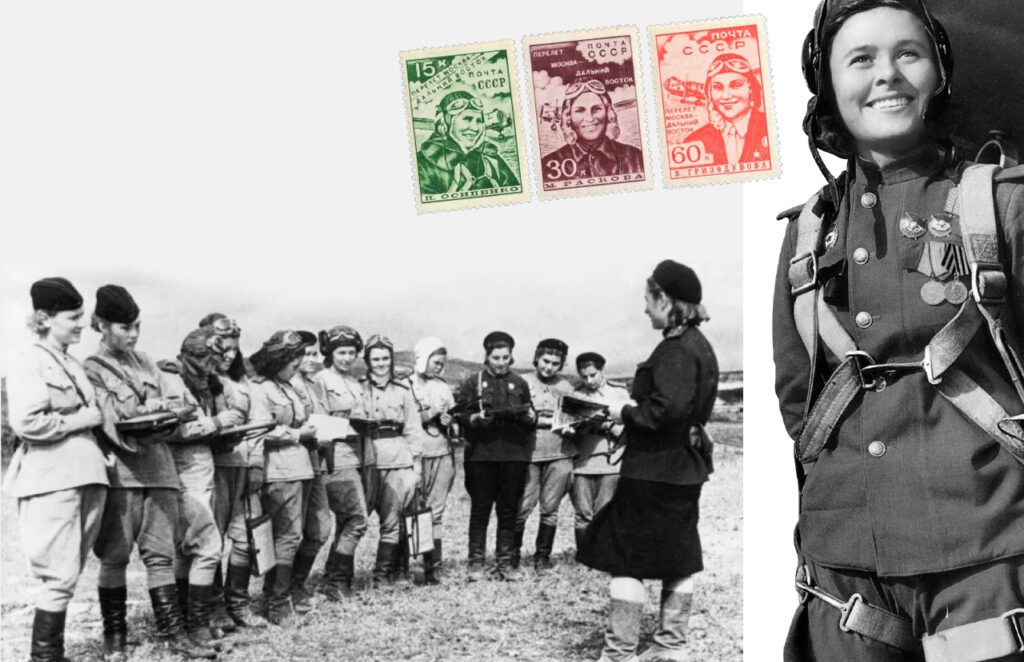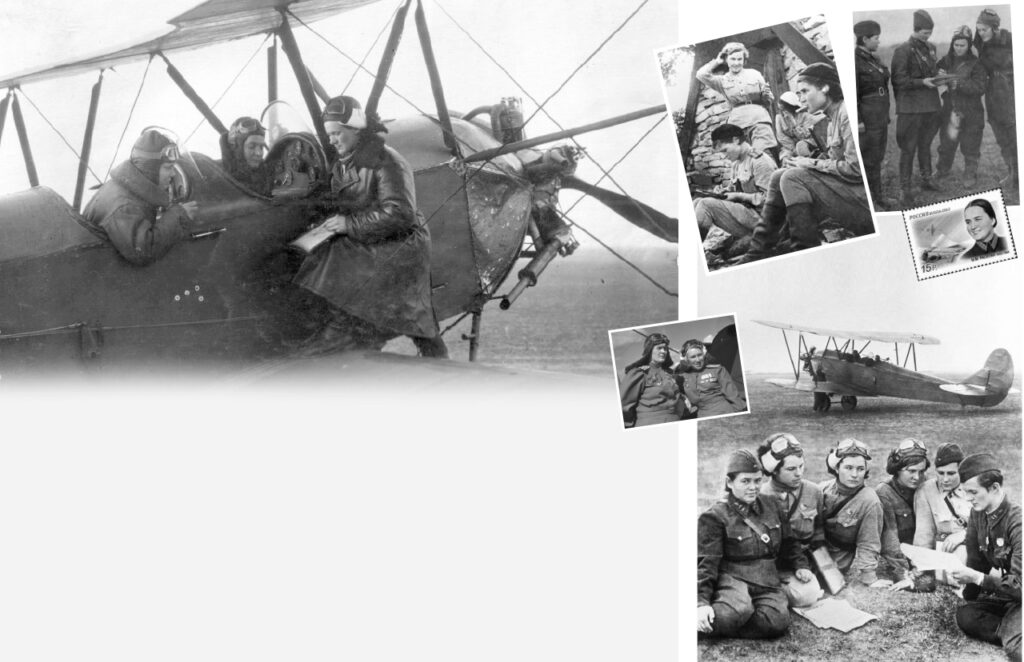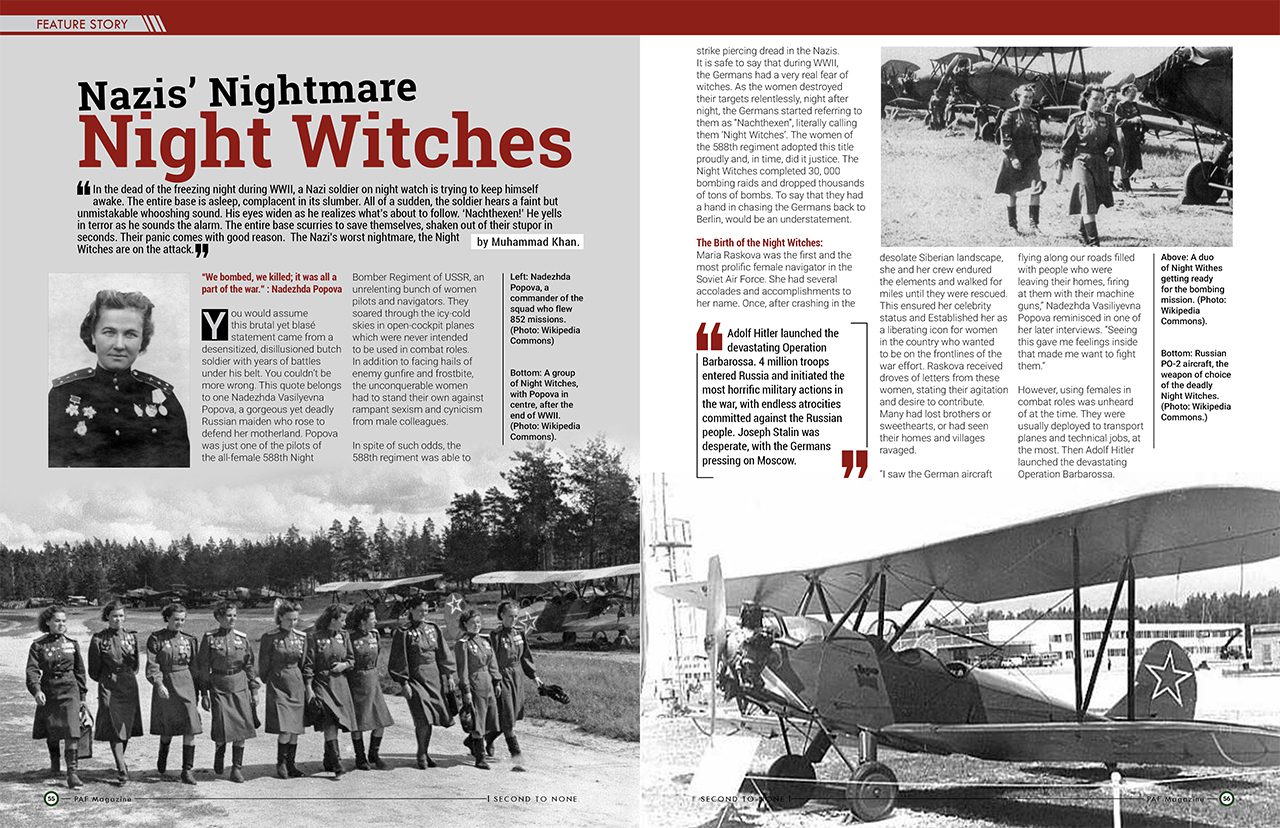In the dead of the freezing night during WWII, a Nazi soldier on night watch is trying to keep himself awake. The entire base is asleep, complacent in its slumber. All of a sudden, the soldier hears a faint but unmistakable whooshing sound. His eyes widen as he realizes what’s about to follow. ‘Nachthexen!’ He yells in terror as he sounds the alarm. The entire base scurries to save themselves, shaken out of their stupor in seconds. Their panic comes with good reason. The Nazi’s worst nightmare, the Night Witches are on the attack.
“We bombed, we killed; it was all a part of the war.” : Nadezhda Popova
You would assume this brutal yet blasé statement came from a desensitized, disillusioned butch soldier with years of battles under his belt. You couldn’t be more wrong. This quote belongs to one Nadezhda Vasilyevna Popova, a gorgeous yet deadly Russian maiden who rose to defend her motherland. Popova was just one of the pilots of the all-female 588th Night Bomber Regiment of USSR, an unrelenting bunch of women pilots and navigators. They soared through the icy-cold skies in open-cockpit planes which were never intended to be used in combat roles. In addition to facing hails of enemy gunfire and frostbite, the unconquerable women had to stand their own against rampant sexism and cynicism from male colleagues.
In spite of such odds, the 588th regiment was able to strike piercing dread in the Nazis. It is safe to say that during WWII, the Germans had a very real fear of witches. As the women destroyed their targets relentlessly, night after night, the Germans started referring to them as “Nachthexen”, literally calling them ‘Night Witches’. The women of the 588th regiment adopted this title proudly and, in time, did it justice. The Night Witches completed 30, 000 bombing raids and dropped thousands of tons of bombs. To say that they had a hand in chasing the Germans back to Berlin, would be an understatement.
The Birth of the Night Witches:
Maria Raskova was the first and the most prolific female navigator in the Soviet Air Force. She had several accolades and accomplishments to her name. Once, after crashing in the desolate Siberian landscape, she and her crew endured the elements and walked for miles until they were rescued. This ensured her celebrity status and Established her as a liberating icon for women in the country who wanted to be on the frontlines of the war effort. Raskova received droves of letters from these women, stating their agitation and desire to contribute. Many had lost brothers or sweethearts, or had seen their homes and villages ravaged.

“I saw the German aircraft flying along our roads filled with people who were leaving their homes, firing at them with their machine guns,” Nadezhda Vasiliyevna Popova reminisced in one of her later interviews. “Seeing this gave me feelings inside that made me want to fight them.”
However, using females in combat roles was unheard of at the time. They were usually deployed to transport planes and technical jobs, at the most. Then Adolf Hitler launched the devastating Operation Barbarossa.
4 million troops entered Russia and initiated the most horrific military actions in the war, with endless atrocities committed against the Russian people. Joseph Stalin was desperate, with the Germans pressing on Moscow. It was the perfect time for Maria Raskova to strike. She approached Stalin with the stack of letters she had received and petitioned him to form an all-female combat squadron. Luckily for Raskova, Stalin was a fan.
On 8th October, 1941, Stalin officially formed 3 all-female air force units, appointing Raskova as colonel of all 3 regiments. Out of these 3, only 1 remained exclusively female, from the pilots to the mechanics. This unit was titled 588 Night Bomber Aviation Regiment, with young women ranging in age from 17 to 26 transferring to the small town of Engels to begin flight training. The recruits underwent a highly compressed Training regiment, with a course originally 2 years in length boiled down to 6 months. Recruits were expected to juggle between the roles of pilots navigators, maintenance and ground crew. Raskova grilled them hard. The fearless colonel also prepared them for the cynicism and sexism that the regiment was sure to encounter from their male colleagues.
The women of the 588 regiment did not have it easy. The top brass had no time to make special arrangements for their femininity or separate requirements. As the graduates began their careers, they were supplied with men’s uniforms. Oversized and not made for feminine figures, the uniforms were a substantial deterrent to good performance. The boots were also standard military size 42. The girls had to stuff them with rags torn off their beddings to keep them from slipping off. A similar improvisation was required for the wide-waisted trousers, tying them tightly with belts. The girls improvised and altered their uniforms to the best of their abilities. They were made to cut their hair short. As one of the pilots would reminiscence in an interview years later, “We didn’t recognize ourselves in the mirror—we saw boys there.”
‘Coffin with Wings’:
They were not even provided with the standard combat equipment that every male soldier received. Flying out for multiple sorties every single night, they had to face death without parachutes, guns, radios or radars. Navigating with compasses and maps, these the 40 or so two-woman crews flew 8 or more missions every single night. However, the plane selected for these young aces, the rudimentary Polikarpov Po-2, a two-seated, open-cockpit biplane, overshadowed all of these problems. Constructed from plywood and covered by canvas, these planes were repurposed crop dusters, never intended to fly in combat roles and obsolete even then. The planes had open cockpits, which meant zero fortification against the elements. Since the Night Witches were a night-time raid force, this meant the pilots flew in sub-zero temperatures, ice-cold winds and the constant risk of frostbite. Some veterans of the regiment later revealed that a number of new recruits had torn their skins off by touching the exterior of the icy plane without gloves. Nadezhda Popova remembers, “In winter, when you’d look out to see your target better, you got frostbite. Our feet froze in our boots, but we carried on flying.”

Ironically, even in these freezing conditions, the 100 HP biplanes were highly flammable, bursting into flames instantly if hit by tracer bullets. It had zero armour and the Germans’ predominant tactic of dealing with the intruders was firing as much as possible from as many guns as possible. Add to that the fact that the biplanes Po-2 could fly on low altitudes when armed, the Night Witches had to sail through a wall of enemy fire almost every single night. The Germans initially dismissed the Night Witches’ Po-2s as “Nähmaschinen” – “Sewing Machines” because of their silent flight.
Once, after a successful flight, a pilot of the regiment counted 42 bullet holes in her tiny plane. There were even bullets in her map. Not even her helmet was spared. “Katya, my dear,” the pilot confided to her navigator, “We will live long.”
For all its flaws, the Polikarpov Po-2s had a few surprising and devious advantages over the German combat planes. The biplanes were so tiny in scale that radars could not detect them. Another double-edged sword was the lack of radios, which meant radio locators could not detect them either. They were relatively silent, especially so when their engines were turned off. Their size also meant that they could be taken off from and landed to any small clearing. However, the advantage that tipped the odds in favour of the Po-2s was the fact that their maximum speed was slower than the stall speed of the Nazi planes, particularly the ‘Messerschmitts’. This meant that the little planes could outmanoeuvre their opponents, which was no small cause for frustration for the Germans, whose planes had to take long, tedious turns. The little unforeseen factor worked for the Night Witches beautifully, making their tiny little biplane much harder to shoot.
Beware of the Night Witches:
The biplane had the capacity to carry only two bombs at a time, one under each wing. To do as much damage as possible to the Germans forces, the regiment curated an itinerary, which compromised of 40 two-person crews undertaking 8 or more missions every single night. They flew back to re-arm between sorties. The main objective of the 588 Regiment was unconventional warfare. They were to ensure that the German never felt secure, not in their own bases, not even at night. They were assigned to drop as many bombs over German front lines as possible, with the objective of making them lose sleep and killing enemy soldiers in the process.
The tactic they employed was as dangerous as it was effective. Three planes would take off at midnight, flying barely above treetop level. Two of these planes would go in first as decoys, attracting attention and fire towards themselves. They would then twist wildly to avoid enemy fire. During this commotion, the third plane would kill its engine and glide towards the target, to avoid detection. It would deliver its payload and disappear into the darkness. The planes would then rotate roles until all 3 had delivered their payloads. It was a regular occurrence during these raids that one of the crew would have to physically climb onto the wing of the plane to dislodge a bomb or pull a stuck release wire to drop it.
The plane which would turn off its engine and glide to its target made a subtle yet iconic ‘whooshing’ sound. This infamous sound was likened by the German soldiers to the sound of a broom of a witch flying in the wind. Thus, the Germans started referring to them as “Nachthexen” which literally translates to ‘Night Witches’, a title which the women eagerly adopted with pride. The Germans came up with outrageous stories to rationalize the ‘Night Witches’ prowess, speculating that the Soviet injected them with serums which gave them the night vision of cats or that they were hardened criminals recruited from prisons. In Albert Axell’s book ‘Greatest Russian War Stories: 1941–1945’ a former Night Witch dismissed the claims, saying, “This was nonsense, of course. What we did have were clever, educated, very talented girls.”.
Achievements:

Around 500, 000 Soviet women served in the war. They proved themselves to be paramount Snipers, the likes of Lyudmila Pavlichenko, still thought of as the deadliest female sniper in history. They proved to be excellent tank commanders and even operated anti-aircraft artillery. However, as a group, the Night Witches were unparalleled in their contributions. 89 women from various services were awarded the highest accolade of the Soviet Union. Out of these 89, 22 were proud members of the Night Witches of the 588 Night Bomber Regiment.
By the time the war came to an end, the 588 Regiment had under their oversized belt a total of 30, 000 bombing raids, dropping almost 23,000 tons of explosives on German targets. 30 Night Witches lost their lives to the cause.
The Night Witches flew their first mission on 28 June 1942. They dropped their last bomb on 4 May 1945. Three days later, Germany surrendered. Maria Raskova, the mother of the regiment, lost her life in a crash on the front lines on 4 January, 1943. She was honoured with the first state funeral of World War 2. Despite being highly decorated and winning hearts across the Soviet Union, the regiment was disbanded 6 months after the war. Sadly, they were also overlooked in the victory-day parade which took place in Moscow. The official reason; their planes were just too slow.
Nobody can deny the part they played in ensuring victory for the Soviet Union and heavy physical and psychological damage they did to the German forces. After they had done their part, they did not seek fame or even spoke publicly of their achievements. They regarded what they had achieved as something that had to be done and that they simply responded when the Motherland called. Most of them resumed their lives as homemakers and started families. Some went to achieve amazing feats in careers in aerospace and other fields. The feats that these women accomplished can and shall never be forgotten. With their navigational pencils which doubled as make-up and their little Polikarpov Po-2 biplanes with flowers drawn on them, they are the prime example of what women can achieve if given the chance, whatever may be the odds against them.
“I look up into the dark sky,” narrates Nadezhda Popova, “close my eyes and picture myself as a girl at the controls of my bomber, and I think, ‘Nadya, how on earth did you do it?!’”








